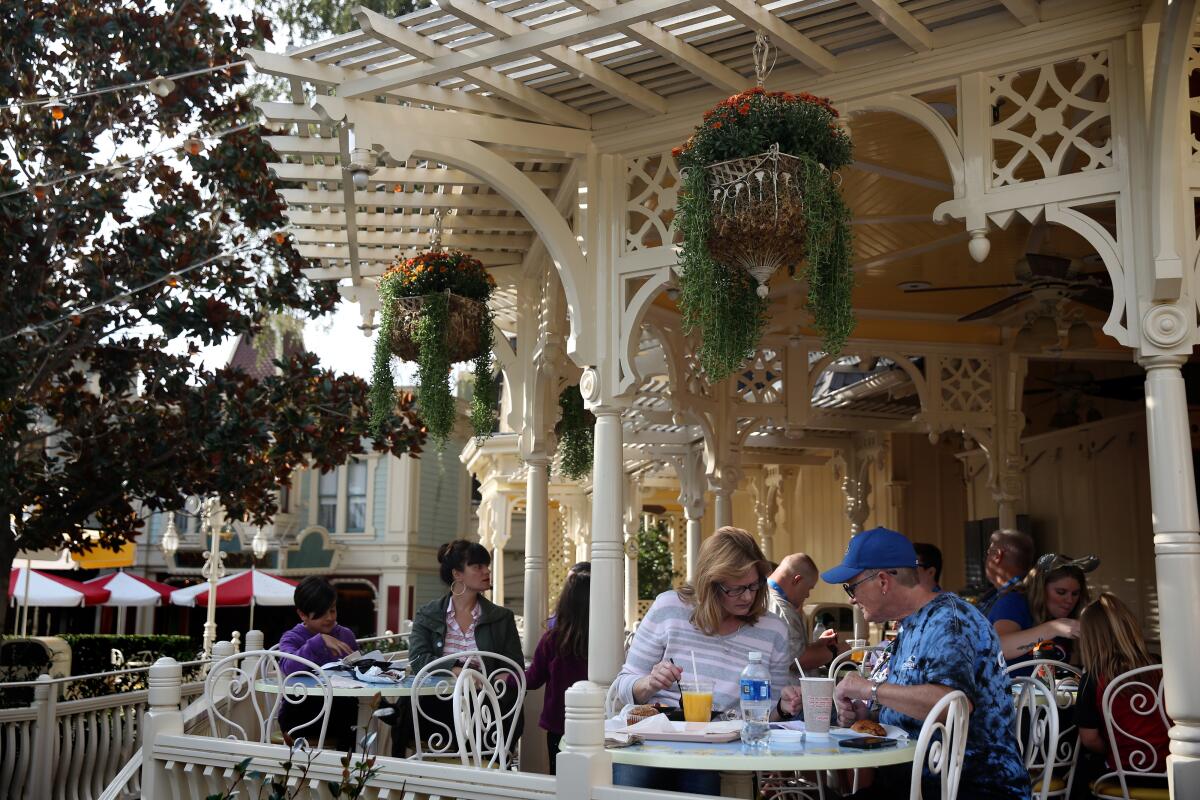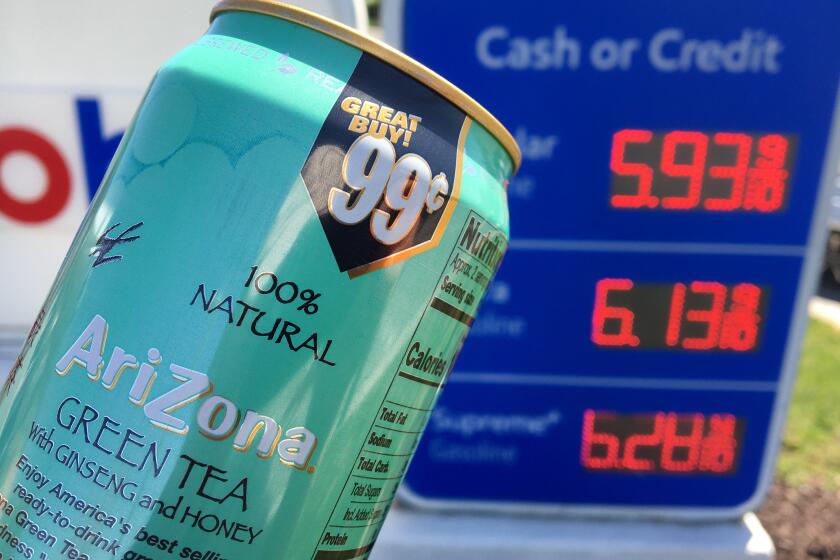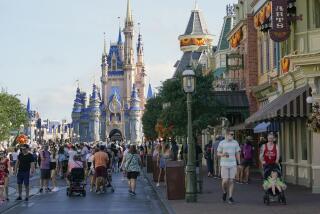Disneyland has been raising food prices. Blame inflation

- Share via
Even within the walls of the Happiest Place on Earth, there’s no escaping inflation.
Disneyland patrons entering the park are used to enduring regular price increases for daily tickets, annual passes and parking. They’ve accepted a new fee to skip the lines on the most popular attractions.
And they’re having to spend more once they get inside as well, with prices on food and drink items rising by as much as 12% over the last two years.
A mint julep that sold for $4.99 in 2020 now costs $5.49. An Angus beef burger that sold for $14.49 two years ago is now priced at $15.49. A drink called the Tatooine Sunset climbed to $5.99 from $5.49 over the same period.
Some customers have also complained about portions shrinking — something a Disney executive suggested during an earnings report last year might be enacted to help save money, but which the company denies doing.
The price increases come as inflation has hit a four-decade high, spurring the Federal Reserve to raise interest rates aggressively in a bid to quell it.
For Disneyland fans, the added food costs come on top of jumps in ticket prices, up as much as 8% last year, and parking, which soared 20%. The new skip-the-line fee, introduced in December 2021, adds $7 to $20 per ride for those who pay it.
Some say they’re fed up.
“I’ve definitely noticed that the prices are going up, and that the ‘price floors,’ depending on the dish, are getting higher and higher,” said Hastin Zylstra, a Santa Ana resident who is a longtime theme park fan.
Tall cans of AriZona iced tea have cost 99 cents since 1992. The family behind the company says it’s committed to that price even as the prices of aluminum and corn syrup climb higher.
He was particularly upset at recently paying $12 for a sandwich at the Sonoma Terrace restaurant at Disney California Adventure, with no side dish. “No chips or anything,” Zylstra fumed.
Disneyland representatives noted that the resort is dealing with the same economic strains facing grocery stores and restaurants. Food prices nationwide jumped 10.5% in the 12 months that ended in June, according to the U.S. Bureau of Labor Statistics.
They also point out that park visitors can bring their own food and nonalcoholic drinks into the park, with some exceptions.
A Times review of six Disneyland and California Adventure Park menus over the last two years found a handful of drops in food prices. Apple juice at the Galactic Grill at Disneyland dropped to $1.99 from $2.69. Funnel cakes at the Hungry Bear Restaurant at Disneyland fell to $7.49 from $8.99.
Of the other food items on the menu in both 2020 and 2022, about as many increased in price as stayed flat.
Food portions at the park have not changed, Disneyland officials say, despite a comment made during a November 2021 earnings report by Christine McCarthy, senior executive vice president and chief financial officer, about ways the company can battle the effects of inflation.
“[T]here are lots of things that are worth talking about,” she said in response to a question by an analyst. “We can adjust suppliers. We can substitute products. We can cut portion size, which is probably good for some people’s waistlines. We can look at pricing where necessary.”
Some park visitors say they have noticed portion cuts.
In the second quarter of 2022, the segment of Walt Disney Co. that includes theme parks collected $6.7 billion in revenue, compared with $3.2 billion a year earlier, soon after the parks reopened from the pandemic.
“Guest spending growth was due to an increase in average per capita ticket revenue, higher average daily hotel room rates and an increase in food, beverage and merchandise spending,” according to Disney’s earnings report.
The rise in theme park prices is not limited to Disneyland. Higher labor costs, fuel price hikes and inflation in general, along with supply chain problems, have pushed food prices up at theme parks across the country, according to industry experts.
“In our industry, yes, food prices have increased necessarily to adjust for the cost of food and labor, but honestly it’s not any different than any restaurant on the street,” said Ken Whiting, a food consultant for the theme park industry and chairman of the International Assn. of Amusement Parks and Attractions.
At the Wizarding World of Harry Potter at Universal Studios Hollywood, Butterbeer, a soft drink flavored with cream soda and butterscotch, sold for $5.50 when the park opened in 2016 ($6.50 for a frozen version). All versions of Butterbeer today sell for $8.00, a 45% price increase.
“Consistent with the food service industry, we adjust prices based on market conditions,” a Universal Studios Hollywood spokesperson said.
On a handful of food items such as churros and popcorn, Disneyland’s prices are surpassed by prices at rival parks such as Knott’s Berry Farm in Buena Park and Universal Studios Hollywood.
In theme parks, just as in grocery stores, managers don’t pass along all price increases consistently across all food items but instead raise prices on those foods that won’t prompt strong pushback from consumers, said John Gerner, a theme park consultant and managing director at Leisure Business Advisors.
Price hikes on some foods, including seasonal offerings such as Christmas cookies or Halloween drinks, won’t spur consumer anger as much as increases on more typical items such as hamburgers and soft drinks, industry experts say.
Theme park managers “are in a dilemma right now,” he said. “They are feeling their way on all of these questions.”
More to Read
Inside the business of entertainment
The Wide Shot brings you news, analysis and insights on everything from streaming wars to production — and what it all means for the future.
You may occasionally receive promotional content from the Los Angeles Times.












